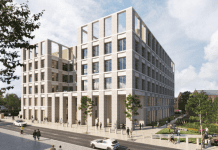Will the Government’s recently announced exceptional talent visa for architects ease the skills shortages in UK construction? How can employers take advantage to address their recruitment needs? Immigration lawyer Anne Morris explains
The exceptional talent visa is an existing scheme under ‘Tier 1’ of the UK’s points-based immigration system, designed for individuals who can demonstrate ‘exceptional talent’ in the fields of science, arts, engineering, humanities, digital technology or, as of 10 January 2019, architecture.
2,000 exceptional talent visas are made available each year, divided between eligible professions. To qualify, applicants have to be endorsed by a designated trade body. For architects, this is RIBA in conjunction with the Arts Council England.
The visa is also open to individuals demonstrating ‘exceptional promise’ in one of these specialist fields.
Under the visa, individuals can come to the UK to live, work – either as an employee, self-employed or the director of a company – study or volunteer. Visa holders do not have to work in their field (unless they want to apply to settle here) and they don’t have to inform the Home Office of a change in job or employer. They can also bring family members with them to the UK.
Visa holders can stay in the UK for a maximum of 5 years if they apply from within, or 5 years and 4 months if they applied from outside the country. It’s then possible to apply to extend the visa for a further 5 years.
After 3 years on the exceptional talent visa, or 5 years as exceptional promise, holders become eligible to apply for indefinite leave to remain.
Why is the visa needed?
Shortages of architects in the UK continue to be a challenge for the construction sector as a whole. With Brexit a matter of weeks away, and with it the removal of freedom of movement, the future of employers reliant on EU workers remains uncertain.
According to recent ARB figures, EU nationals accounted for over 20% of the Register as at August 2018, but since 2016 there has been a 42% decrease in the number of architects registering with EU qualifications.
A diminishing supply of EU workers, combined with persistent deficiencies in the domestic talent market, is forcing businesses to look beyond Europe to meet recruitment needs.
Recent years have seen the termination of many visa UK routes that historically would have assisted the profession, such as the Tier 1 (General) visa, while remaining visa routes offer limited – and costly – scope for businesses to address the skills gap.
UK employers can make use of the Tier 2 visa to ‘sponsor’ skilled non-EEA workers, but this carries significant financial and administrative commitments, including payment of the Immigration Skills Charge, the Tier 2 visa application and Immigration Health Surcharge.
The Tier 2 application process is demanding on both the employer and applicant, with no guarantee. There are also limitations on the type of work that can be carried out, salary level, working hours and locations. Strict reporting duties are also imposed, to keep the Home Office informed of changes to the employee and employer circumstances.
Architecture is also an exceptionally difficult sector for students and trainees – there were 12,875 international students in architecture, building and planning in 2016/17. Current visa options are again limited given the length and cost of training, and challenges of then breaking into the job market.
By comparison – the exceptional talent visa offers a more flexible solution supportive of talent mobility and business needs within the industry at both the experienced and promising levels of talent.
How can architects apply for the exceptional talent visa?
Applicants must be nationals of a non-EEA country or Switzerland. They must have secured professional endorsement for architecture as either a recognised leader (exceptional talent) or an emerging leader (exceptional promise). Applications for endorsement are made online via the Home Office website. This stage costs £456.
The standard is high. Applicants will have to evidence their status as an established world leader in their field for exceptional talent or have the potential to become a world leader for exceptional promise.
Once endorsed, the next step is to apply to the Home Office for the visa. This application will involve confirming the applicant’s eligibility under the route and that they satisfy the general grounds for leave to enter or remain in the UK.
Under the exceptional talent route, the general grounds are relaxed and do not include the English language requirement or proof or maintenance funds.
The visa application can be submitted up to 3 months before the date of travel.
The costs of this stage of the application is £152, or £97 if the applicant is from Turkey or Macedonia.
It is possible to switch to this visa category from another UK visa, such as another Tier 1 visa, Tier 2, or certain Tier 5 categories. Applicants currently holding a UK visa or leave to remain must apply for stage 2 before their current visa or leave expires.
Applicants also have to pay the Immigration Health Surcharge at £400 per annum to cover the duration of their stay.
How will the new visa affect the industry & employers?
As an opportunity for skilled and promising architects to work in the UK, we are welcoming the Government taking a sensible approach to attracting architects.
Under the current rules, it has been incredibly difficult for members of the profession to come to the UK, either to be employed or to set up their own practice. So we expect the scheme will become popular across the UK architecture industry.
We also expect take-up among graduates to be high via the exceptional promise route.
For UK employers, employing architects under the new visa will mean consideration of recruitment and onboarding processes and policies; supporting applicants though the Home Office process and reminding employees of visa expiry to ensure they are not in breach of their visa conditions and that employers are not then employing an illegal worker.
In the run up to Brexit, we will continue to see announcements on changes to UK immigration rules. This will impact how businesses employ non-UK resident workers.
Anne Morris
Managing Director
DavidsonMorris
https://www.davidsonmorris.com/
Twitter: @DavidsonMorris
Twitter: @ImmigrationAnne
020 7494 0118

















